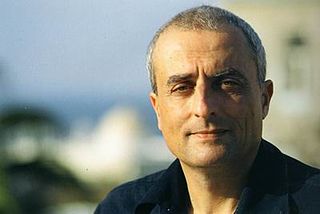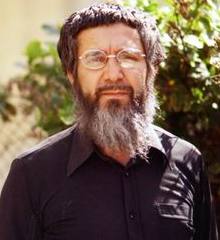
Zeev Kun (born 16 April 1930, died 20 June 2024) was an Israeli painter of Hungarian origin. He is the father of the artist Shay Kun.

Zeev Kun (born 16 April 1930, died 20 June 2024) was an Israeli painter of Hungarian origin. He is the father of the artist Shay Kun.
Zeev Kun was born in the city of Nyíregyháza in northeastern Hungary. As a teenager, he worked at an art supply store owned by his parents, Blanka and Sandor. After the deportation of Hungarian Jews began in March–April 1944, 14-year-old Zeev Kun was first sent to Auschwitz concentration camp, then to Jaworzno concentration camp, located 23 kilometers away from Auschwitz and used as its outer branch, and from January to April 1945 he was imprisoned at the camps of Gross-Rosen, Buchenwald and Flossenbürg; [1] on April 23, 1945, the prisoners of the camp Flossenbürg were freed by American troops. In late August 1945, Zeev Kun came back to Hungary, and with the Auschwitz concentration camp tattoo still visible on his arm, he resumed school. Later, he entered the Magyar Képzőművészeti Főiskola in Budapest (nowadays called Hungarian University of Fine Arts) in the fall of 1947, where he studied for over a year and a half. In 1949, as the new pro-communist political regime was growing more and more repressive, Zeev Kun joined a group of thirty Jews from the leftist Zionist organization "Hashomer Hatzair" and managed to secretly cross the Czech border, and later he arrived to Italy via Austria. In the city of Bari, the group boarded a ship that brought them to Israel. Once in Israel, Zeev Kun first settled at the kibbutz Givat-Haim near Hadera. He did not stay there for long, though, as in 1951 he became a student at the Akademie der bildenden Künste Wien Academy of Fine Arts in Vienna, [2] as the city had just witnessed the birth of the so-called Vienna School of Fantastic Realism. Students and young professors of the Academy sought to reflect upon the tragedy of World War II, still maintaining a dialog with the masters of German Renaissance (such as Hieronymus Bosch and Pieter Bruegel the Elder), as well as the pioneers of surrealism of 1920s and 1930s, first of all Max Ernst (1891–1976). At the Academy, Zeev Kun was close to Anton Lehmden (born in 1929) and Ernst Fuchs (1930–2015). In his art, the latter focused on the images of Apocalypse, creating paintings shot through with dread and fear of death. It is no wonder that Zeev Kun, who himself survived the nightmare of Auschwitz and Buchenwald, was so overwhelmed by the works of Fuchs, who happened to be his peer. [1] Upon his return to Israel, Zeev Kun joined the Israeli Painters and Sculptors Association. In 1973 he was awarded the Max Nordau Prize for Arts [3] and in 2023 - the Moshe Castel Prize for the outstanding contribution to the Israeli art [4] . His paintings have gained acclaim from art lovers in the Israeli non-Jewish sector, as well; they have been sold by their Alkara Art Gallery in Daliyat al-Karmel, Israel's largest Druze town. [5]
His perfectly mastered technique allowed him to accomplish a wide range of artistic goals, as he came up with philosophic and allegoric interpretations of the Holocaust and its ever-present memory, never to be overshadowed by the Jewish national revival in Israel and in a number of countries hosting Jewish diasporas. He exhibited in many Israeli cities (e.g. Jerusalem, 1954, Tel Aviv, 1959, 1961, 1963, 1964, 1968, [6] 2014), [7] and Nahariya (1988), [8] as well as in Brussels (1960), Paris (1962, 1972, 1994), London (1965), Sydney (1967), New York City (1968), [9] Los Angeles (1968), Detroit (1970), Amsterdam (1972), Stockholm (1975), Antwerp (1976) and Berlin (1987). For many years, the painter worked in Safed, where he held his own gallery, but later he returned to Tel Aviv, where he lived until his death.
Zeev Kun's works have been successfully sold by leading Israeli auction houses on many occasions, including "Tiroche", "Matsart", "Montefiore", "Egozi" and others. According to art critic professor G.Recanat, Zeev Kun's paintings have always been highly appreciated and valued by art collectors and art lovers. [10]

Igael Tumarkin was an Israeli painter and sculptor.
Heddy Kun is an Israeli painter.

Ze’ev Raban (22 September 1890 – 19 January 1970), born Wolf Rawicki (Ravitzki), was a leading painter, decorative artist, and industrial designer of the Bezalel school style, and was one of the founders of the Israeli art world.
Itzchak Tarkay was an Israeli painter and graphic artist. He used trade dress to protect his style from being emulated via Romm Art Creations Ltd. v. Simcha International, Inc., a case that Tarkay won.

Yitzhak Yamin was an Iraqi-born Israeli painter and sculptor.
Nachume Miller (1949–1998) was an Israeli artist who immigrated to New York City in 1973, where he made a name for himself in the American Modern Art scene. Miller's parents were both Holocaust survivors. His father was a captain in the front lines of the Russian Army during World War II and his mother was a Lithuanian who had once been held captive in a concentration camp. Both escaped the Nazis, re-united and fled to Israel. Nachume was born during their voyage, in Frankfurt, Germany, on January 28, 1949. He grew up in the town of Holon, Israel, where he was inspired by his father who spent most of his post-war days carving elaborate wood sculptures of Cubist human forms. Nachume, on the contrary, excelled in painting.

Ofer Lellouche is an Israeli painter, sculptor, etcher and video artist.

Pinchas Cohen Gan is a Moroccan painter and mixed-media artist. He was awarded the Sandberg Prize (1979), the Culture and Sport Ministry's prize for his life's work (2005), and the Israel Prize in Art (2008).

Naftali Wahba Bezem was an Israeli painter, muralist and sculptor.
Mieczysław Baryłko was a Polish painter.He had graduated from the Mikołaj Rej Gymnasium in Warsaw. During the World War II, Mieczyslaw attended the Lycée for Machine Construction at the Wawelberg School. On 20 January 1943, he was arrested by Gestapo and detained in prison "Pawiak". He was subsequently imprisoned in the concentration camps of Auschwitz, Gross-Rosen and Flossenburg until the end of the War in 1945. He returned to Elbląg in Poland where he started to work as a technician in the zinc and tin department of the Factory of Metal Goods. Next, he moved to Gdańsk, where he could finally realise his old dream and complete the studies in art at The State College for Visual Arts [PWSSP] in Gdańsk with the seat in Sopot. He graduated in 1953, but from 1950 to 1972 he worked in his college. Initially, he was an assistant, then an adjunct and a senior lecturer. He participated in the painting works during the reconstruction of Old Town in Gdańsk. In the years 1956-1958 and 1968–1969, he was the Chairman of the Association of Polish Painters and Designers Branch in Gdańsk. He works are in the collections of the National Museums in Warsaw, Gdańsk and Szczecin, the Historical Museum of the City of Gdańsk, the Dresden Gallery and private collections.

Avraham Eilat is an Israeli artist, educator and curator. He graduated from the Hebrew Gimnasium Herzliya in Tel Aviv, and was enrolled in Hashomer Hatzair youth movement for nine years starting at age 9. After military service in 1960 he joined in Kibbutz Shamir, situated on the western slopes of the Golan Heights in the Upper Galilee, where he was a member until 1978. During his first years in the kibbutz, Eilat was a shepherd side-by-side with his kibbutz adopting father the painter Moshe Cagan. Close contact with nature and its phenomenon and the features of local landscape deeply influenced his way of thinking and established the themes appearing along all his career in his art. The contrast between man-made geometrical shapes of fish ponds and the free flowing of the flora and typical hilly landscape of the Hula Valley area, crystallized his visual language and determined its formal and thematic foundations. Avraham Eilat employs skillfully various means of expression: drawing and painting, etching, photography, sculpture, installation, and often a combination of more than one. Using those means enriches his basic statement and makes it complex and multi-layered. Avraham Eilat lives in Ein Hod Artists Village, Israel, with his spouse Margol Guttman, works in his studio in Pyramida Center of Contemporary Art, Wadi Salib, Haifa, and in his studio in Ein Hod.
Pinhas Golan was an Israeli artist and sculptor. Golan was a Holocaust survivor and his work focused on the subject.
Aharon Gluska is an Israeli–American painter.

Nir Hod is an Israeli artist based in New York.
Eugen Kolb was an art critic, theorist of art and director of the Tel Aviv Museum of Art from 1952 until his death in 1959.
Albert Sauer was a Nazi German commandant of Mauthausen-Gusen concentration camp. He died of wounds in 1945, and was never tried for his role in The Holocaust.
Shay Kun is an Israeli-American painter known for post-modern interpretation of the Hudson River School movement. He is the son of Israeli painter Zeev Kun.
Avner Avraham is a former Mossad official artist, journalist, deputy editor of the "Intelligence Heritage Center" magazine, curator of spy and art exhibitions, curator, and producer of spy films, founder and owner of the international lecturer agency 'Spy Legends', and 'Women Speakers Online'.

Tova Berlinski was a Polish-born Israeli painter who was considered to be a doyenne of the painting community in Jerusalem.

Mordechai Levanon was an Israeli painter. He was one of the foremost Israeli landscape painters. He was the winner of the Dizengoff prize in 1940 and 1961. He was enchanted by Erez Israel's light, and the cities of Safed and Jerusalem; all of which feature heavily in his paintings.